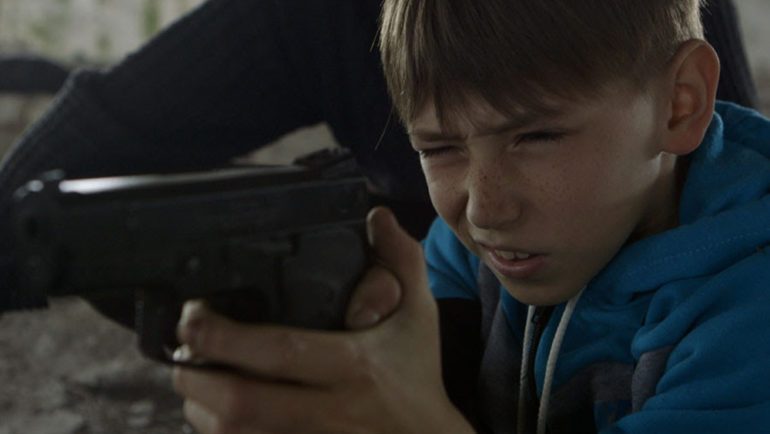Film Review: ‘The Distant Barking of Dogs’
By Guy Lodge
LOS ANGELES (Variety.com) – There’s rueful misdirection in the title “The Distant Barking of Dogs,” even if it isn’t strictly inaccurate: For much of Danish docmaker Simon Lereng Wilmont’s stoically compassionate fly-on-the-wall wartime portrait, a steady bassline of vocal canine discontent hangs in the background, becoming as integral to the scenery as a summertime cicada chorus. Yet in the tiny Ukrainian village of Hnutove, a stone’s throw from the frontline of the War in Donbass, it’s not the ever-present barking that keeps fretful residents up at night; that’s mere white noise beside the constant rattle of gunfire and shellfire from the adjacent war zone.
For young Oleg Afanasyev, orphaned and living in Hnutove with his wily, resilient grandmother Alexandra, the familiarity of this soundtrack makes it no easier to ignore as the years crawl by. Beautifully observed and edited across a three-year timespan, Lereng Wilmont’s film — an impressive solo feature debut, following an early collaboration with Russian heavyweight Viktor Kossakovsky — subtly depicts the low-level normalization of that panic. An unexpected but eminently worthy selection for this year’s Oscar documentary shortlist, “” has been quietly racking up kudos on the festival circuit since scooping the First Appearance Award at IDFA in 2017. U.S. distribution has yet to materialize, though the Academy’s endorsement should boost the prospects of an unsentimental work that, however upsetting, invites universal empathy.
Though the film fits into a growing subset of cinematic responses to the ongoing conflict between Ukraine and the Russian-supported Donetsk People’s Republic, it demands little knowledge of the situation’s complexities from its audience: After introductory title cards lay out the bare factual essentials, Lereng Wilmont largely assumes the naive perspective of Oleg. Just 10 years old at the film’s outset, his understanding of war comes down to sound and sensation, which is altogether frightening enough.
With his mother having died in unexplained circumstances some years before — painting and maintaining her grave is a fixture of his routine — he is fiercely protected from uglier realities by Alexandra, though she must find her own ways to manage her terror. At times she rocks Oleg and his younger cousin Yarik to sleep as artillery fire blusters nearby; at others, she takes to vigorous housework so the children won’t see her hands shaking. Others in the village, including Yarik and his mother Alyona, attempt fleeing to safety, but Alexandra is steadfast in her determination to weather it out on the frontline: “Every dog is a lion in its own home,” she tells Oleg, and he gradually inherits a measure of her prideful resistance to the horrors around them.
But there’s a downside to that toughening, as hard-won hardiness combines with adolescent macho posturing to dangerous effect. Under the influence of rebellious older lad Kostya, Oleg and Yarik are introduced to the weaponry that is causing such havoc along the banks of the Kalmius River: Firearms, bullets and landmines are fetishized as objects of masculine fascination, casting an alluring sheen to a conflict the boys can see and hear, but still not fully comprehend. Scenes of recklessly cruel gunplay, with cautionary consequences, are the most disquieting in a film that runs on a permanent sense of agitation: Boys may be boys, it suggests, but isn’t that what starts wars in the first place?
Without a word of narration, then, “The Distant Barking of Dogs” deftly weaves a precise coming-of-age narrative into its morally urgent anti-war tableau. Working from several years’ worth of footage, editor Michael Aaglund deserves particular credit for so fluidly tracking Oleg’s maturing personality and perspective against such a disruptive chapter of running history. Acting as his own cinematographer, Lereng Wilmont likewise toggles internal and external crisis with his alert, inquisitive camera, often zeroing tightly in on the anguished faces of his principal subjects before pulling back to reveal a landscape pockmarked by pain and damage. Yet flashes of dusky-lit beauty often survive the surrounding carnage, either in nature or in Oleg and Alexandra’s safe, loving domestic space. “Hope blossoms like greens,” she observes in peculiarly regional fashion, “ready to be pickled in a glass jar.” Lereng Wilmont’s subjects earn their stray moments of rustic poetry; so does his film.

